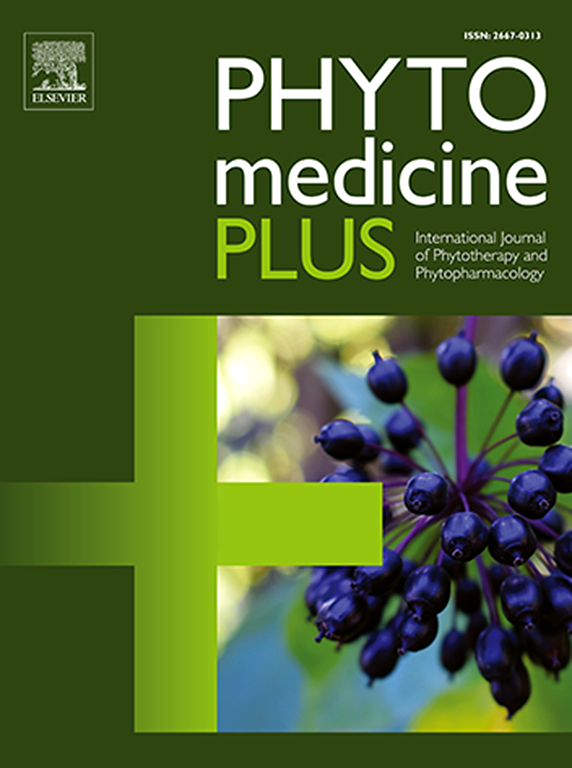Neuropharmacological profile of Ḥabb-e-Ṣar‘: A Unani pharmacopeial formulation for epilepsy
Q3 Pharmacology, Toxicology and Pharmaceutics
引用次数: 0
Abstract
Background
Epilepsy, known in Unani medicine as Ṣar‘, is a neurological disorder caused by abnormal neuronal activity that manifests as recurrent, unprovoked seizures, often with frothing from the mouth. The conventional anti-epileptic drugs carry several adverse effects, and it is also documented that nearly 30 % of the patients fail to respond to therapy. In recent years, there has been a growing interest in the use of plant-based anti-epileptic drugs due to their efficacy in controlling seizures, and other beneficial effects like neuroprotection, multi-dimensional actions, and long-term safety, which are not seen with conventional drugs. In this context, Ḥabb-e-Ṣar‘ is a Unani pharmacopeial formulation which contains Aloe vera (L.) Burm.f. leaf pulp, Boswellia serrata Roxb. oleo-gum resin, and Castoreum; and is prepared as small pills. It is widely used by Unani physicians in India for the management of epilepsy in both children and adults.
Purpose
This study is aimed to explore the neuropharmacological activity of the ingredients of Ḥabb-e-Ṣar‘, a Unani anti-epileptic medicine, to understand its action-mechanism and efficacy in epilepsy management.
Methodology
The neuro-pharmacological activity of three ingredients of Ḥabb-e-Ṣar‘ was explored in research articles published between 1996 and 2024 on leading scientific websites, in which any of the three ingredients or their extracts were studied in single form.
Results
Several bioactive constituents present in Ḥabb-e-Ṣar‘have a dose-dependent anti-seizure activity, among other important actions which are imperative for epilepsy management. For instance, Aloin, Aloesone (from A. vera), incensole acetate, and β-boswellic acid (from B. serrata) demonstrate a dose-dependent anti-seizure activity. Acetyl 11-keto-β-boswellic acid is attributed with a neuro-protective effect, improves cognition, relieves anxiety, and has also been demonstrated to cause neuronal repair after injury. Phenolic acids and anthraquinones present in A. vera are known to protect against neuronal death. Salicin present in castoreum is the precursor of salicylic acid, which lowers calcium ion reflux and blocks seizures. Hence, the combined effects of these ingredients in Ḥabb-e-Ṣar‘ can effectively help in managing the symptoms and long-term complications of epilepsy.
Conclusion
This review provides a detailed insight into the actions and neuropharmacological activity of the ingredients of Ḥabb-e-Ṣar‘. It is evident that the ingredients of Ḥabb-e-Ṣar‘ not only have anti-seizure activity, but also improve memory, cognition, and neurological health, hence leading to a holistic healing effect. However, rigorous scientific studies are required to standardize the formulation and study its interaction with conventional anti-epileptic drugs. With targeted researches, Ḥabb-e-Ṣar‘ may be used in integration with conventional anti-epileptic regime.

Ḥabb-e-Ṣar '的神经药理学概况:一种治疗癫痫的Unani药典配方
癫痫症,在乌干达医学中称为Ṣar ',是一种神经系统疾病,由异常的神经元活动引起,表现为反复的、无端的癫痫发作,通常伴有口吐泡沫。传统的抗癫痫药物有几种不良反应,而且也有记录表明,近30%的患者对治疗没有反应。近年来,人们对植物性抗癫痫药物的使用越来越感兴趣,因为它们具有控制癫痫发作的功效,以及传统药物所没有的其他有益作用,如神经保护、多维作用和长期安全性。在这种情况下,Ḥabb-e-Ṣar '是含有芦荟(L.)的Unani药典配方。Burm.f。叶浆,乳香叶。油胶树脂和蓖麻树脂;制成小药丸。它被印度的Unani医生广泛用于儿童和成人癫痫的治疗。目的研究乌兰尼抗癫痫药物Ḥabb-e-Ṣar′的神经药理活性,了解其治疗癫痫的作用机制和疗效。方法通过1996 - 2024年间发表在主要科学网站上的三种成分或其提取物的单一形式的研究文章,探索Ḥabb-e-Ṣar '的三种成分的神经药理活性。结果Ḥabb-e-Ṣar '中存在的几种生物活性成分具有剂量依赖性的抗癫痫活性,以及其他对癫痫治疗必不可少的重要作用。例如,芦荟素、芦荟酮(来自芦荟)、醋香素和β-乳香酸(来自塞拉塔)显示出剂量依赖性的抗癫痫活性。乙酰11-酮-β-乳香酸具有神经保护作用,改善认知,缓解焦虑,也被证明可以引起损伤后的神经元修复。已知芦荟中存在的酚酸和蒽醌类物质可防止神经元死亡。存在于蓖麻中的水杨酸是水杨酸的前体,可降低钙离子回流并阻止癫痫发作。因此,Ḥabb-e-Ṣar '中的这些成分的综合作用可以有效地帮助控制癫痫的症状和长期并发症。结论对Ḥabb-e-Ṣar '的作用和神经药理活性进行了较详细的介绍。很明显,Ḥabb-e-Ṣar '的成分不仅具有抗癫痫活性,而且还能改善记忆、认知和神经健康,从而产生整体治疗效果。然而,需要严格的科学研究来规范其配方并研究其与常规抗癫痫药物的相互作用。通过有针对性的研究,Ḥabb-e-Ṣar '可以与传统的抗癫痫疗法结合使用。
本文章由计算机程序翻译,如有差异,请以英文原文为准。
求助全文
约1分钟内获得全文
求助全文
来源期刊

Phytomedicine Plus
Medicine-Complementary and Alternative Medicine
CiteScore
3.70
自引率
0.00%
发文量
178
审稿时长
81 days
期刊介绍:
 求助内容:
求助内容: 应助结果提醒方式:
应助结果提醒方式:


